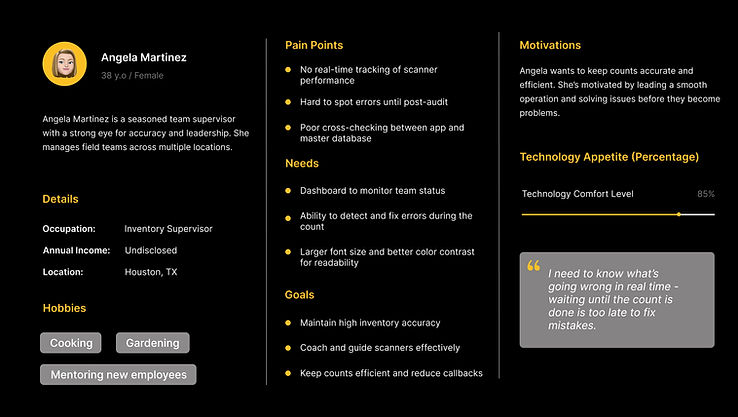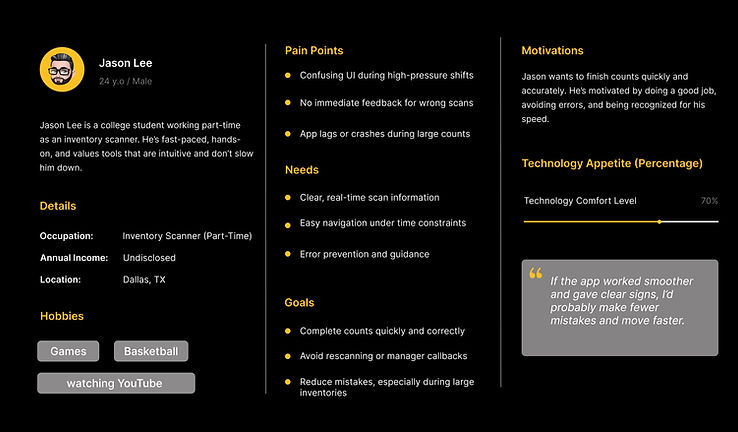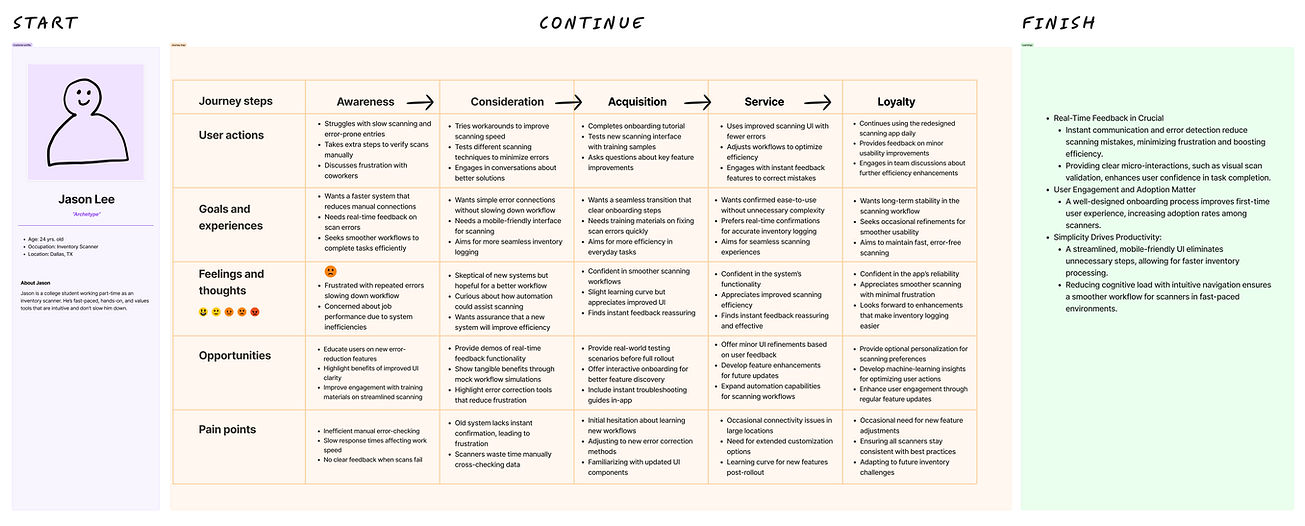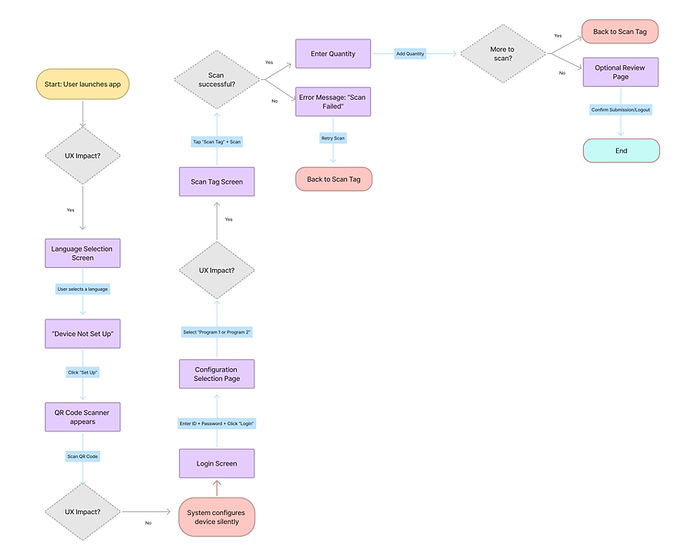
wis international
A streamlined inventory management application to enhance the efficiency for scanners and supervisors
About this project.
As a UX Designer intern at Kairos Technologies, I worked on enhancing the company's digital presence and user experience by creating clickable prototypes and design elements. I helped modernize the company's website by designing new templates and visual components using Adobe XD. Additionally, I collaborated with developers to ensure responsive design components were implemented effectively, improving accessibility and user interaction across devices. My role also involved applying UX design practices to support the development of intuitive and engaging web interfaces.
About the project.
The Flex Count project aimed to redesign WIS International's inventory application to make it more user-friendly for scanners and supervisors. As a UX Design Intern, I conducted in-depth user research by visiting sites like Home Depot to gather feedback directly from scanners. I identified pain points in the existing application and collaborated with senior designers to create wireframes, prototypes, and a reusable component library using Figma. I also contributed to developing a style guide aligned with WIS's brand guidelines and facilitated design implementation through CSS and HTML. My work focused on enhancing usability and improving the overall experience for primary users.

Project Information
1
Project Overview
The Flex count project aimed to redesign the inventory scanning app used by WIS International to improve usability for both scanners and supervisors. The focus was on creating a more intuitive, responsive interface that supports fast-paced inventory environments.
2
Problem Statement
The existing app was difficult to navigate, especially under time pressure. Scanners faced input errors and poor feedback, while supervisors struggled with limited visibility into real-time scanner activity and data inconsistencies.
3
Solution Design
The redesign introduced a simplified interface for scanners, real-time feedback for scan errors, and a dashboard for supervisors to track team performance. Responsive components and user-tested layouts improved usability and reduced confusion across devices.
Design process
1
Discover
-
Conducted interviews and surveys with inventory scanners and supervisors to gather firsthand feedback.
-
Shadowed scanning sessions to observe real-time challenges during inventory counting.
-
Analyzed current tools and workflows to identify friction points.
2
Define
-
Defined primary users needs: a simple, intuitive UI for scanners and a clear overview/dashboard for supervisors
-
Identified key pain points like cluttered interfaces, lack of error feedback, and no real-time sync with the database.
-
Created user personas for both roles to guide decision-making through the design.
3
Ideate
-
Sketched low-fidelity wireframes in Figma to test different layouts for ease of navigation and scanning flow.
-
Created clickable prototypes to simulate scanning and supervisor views for usability testing.
-
Gathered iterative feedback from users and stakeholders to refine UI elements and task flows.
4
Deliver
-
Developed high-fidelity prototypes with polished visuals and consistent branding.
-
Handed off design specs and reusable components to developers, ensuring mobile responsiveness and accessibility.
-
Collaborated in sprint reviews and design QA sessions to track progress.
design strategy
Low-Fidelity Prototypes
To translate the research findings into design concepts, I created low-fidelity wireframes on Figma:
-
Simplified Layout: Reduced the number of screens needed for core tasks.
-
Clear Action Buttons: Ensured primary actions (scanning, confirming entries, were easily accessible)
-
Instant Feedback: Incorporated success/error notifications to confirm when scans were processed.
High-Fidelity Prototypes
Based on feedback from the initial testing, I refined the designs into high-fidelity prototypes:
-
Visual Design: Focused on a clean and intuitive interface, ensuring consistency with WIS International's brand guidelines
-
Enhanced Functionality: Integrated a real-time status bar for instant feedback on scan success or failure, optimized search and filter functionality for quicker access to inventory items, and designed a supervisor dashboard with real-time inventory updates for efficient cross-referencing
-
Accessibility: Ensured the app was mobile-responsive, allowing scanners to use it seamlessly across different devices
USER PERSONAs


customer journey map
.jpg)
USER FLOW (scanner)
%20(1).jpg)
COUNT APP


audit app

supervisor portal


wis design language system




Development Handoff & Implementation
To ensure the designs were accurately implemented, I collaborated closely with developers, creating reusable templates for consistent page layouts and providing responsive design components for smooth integration. I also regularly participated in design reviews to tackle any implementation challenges and ensure the final product reflected the original design vision.
Results & Impact
35%
reduction in task completion time for scanners.
20%
increase in user satisfaction scores, as indicated by post-launch feedback surveys
Reduced data entry errors
by implementing real-time feedback mechanisms
hiGHER ADOPTION RATES
among supervisors and scanners due to the intuitive design and enhanced functionality
CONCLUSION
Redesigning the Flex Count application for WIS International was a transformative experience emphasizing the importance of user-centered design. Through thorough user research, iterative design practices, and close collaboration with developers, I delivered a solution aligned with user needs and business goals. Key takeaways included the value of engaging directly with users to understand their pain points, refining designs through continuous feedback, and working with cross-functionality to ensure the design vision translated seamlessly into the final product.